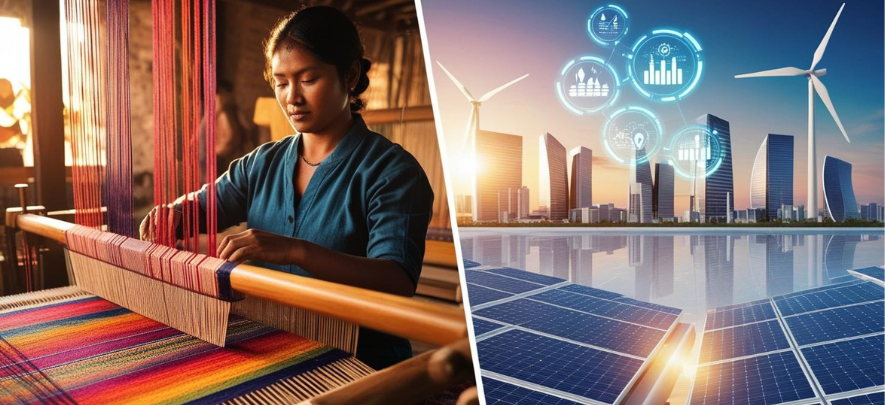Threading Sustainability into Strategy: Business in a Changing Climate

Environment
6 week ago — 4 min read
The climate isn’t the only thing changing—your business model should too.
Stitched Into the Strategy – ESG in Fabric, Finance & the Future
In textiles, every thread matters—so does every business decision.
In the creative world of handicrafts and fashion, environmental awareness is no longer optional. Brands are being held accountable—not just for what they make, but how they make it. From fair wages to carbon footprints, sustainability is now measured as seriously as margins. ESG (Environmental, Social, Governance), CSR (Corporate Social Responsibility), SDGs (Sustainable Development Goals), and Green Certification are more than buzzwords.
They’re the backbone of future-proof decision-making. These strategies help companies manage today’s risks, win consumer trust, and plan for tomorrow. Because in a warming world, sustainability isn’t just good ethics—it’s smart business.
At our organization, we've adopted a new lens: climate risk is business risk. We've embedded climate-related thinking into every financial assumption we make—be it asset life, future cash flow projections, or long-term investments. This shift is a core pillar of our Sustainability 2025 strategy.
Why? Because global warming is not just melting glaciers—it’s already impacting supply chains, insurance premiums, asset values, and energy costs. If we continue to make decisions without accounting for that, we don't just harm the environment—we endanger our own viability.
We’ve seen similar shifts in how companies report diesel asset values due to urban emission laws. Some have shortened truck lifespans and revalued assets to reflect policy shifts—an ESG-aligned move that keeps both books and ethics in balance.
Earlier this year, we looked at building a logistics hub near the coast. On paper, it seemed perfect—solid return on investment in under 7 years, strong workforce nearby, excellent location. But when our team checked climate risks like rising sea levels and heatwaves, we saw the real picture. Cooling costs would be much higher, and the building would need extra protection from floods. The project suddenly looked risky. If we hadn’t considered global warming, we could have lost a lot of money later.
This isn't just a one-off. Under Sustainability 2025, we routinely review assumptions with a climate lens:
-
Will this location be viable in a warmer world?
-
Can this asset withstand extreme weather events?
-
Are our vendors aligned with carbon-neutral goals?
-
How can we make decisions that reduce—not increase—our harm to the environment?
We now include climate scenarios in everything from lease terms to depreciation schedules. Why? Because global warming is not a future issue—it’s a present variable. And ignoring it will only increase our contribution to environmental harm, which we refuse to do.
This is good ethics, good business, resilience, and responsibility. And the planet is watching. We’re proud to make smarter, climate-conscious decisions today—under the promise of Sustainability 2025, which is not just a slogan—it’s a commitment.
The future belongs to those who plan for it—wisely, responsibly, and sustainably. Are you planning accordingly?
Image source: Canva
Disclaimer: The views and opinions expressed in this article are those of the author and do not necessarily reflect the views, official policy or position of GlobalLinker.
Posted by
Renu BhatiaQualified Independent Director/ Corporate Governance . Mrs. Renu bhatia is the proprietor of Flawsome World. She aims to transform the fashion industry for the better. She is...
View Renu 's profile
Other articles written by Renu Bhatia
Most read this week
Trending










Comments
Share this content
Please login or Register to join the discussion